By Jeffrey D. Brasie
Images Courtesy of the Sloan Museum of Discovery
Published 4.3.2024
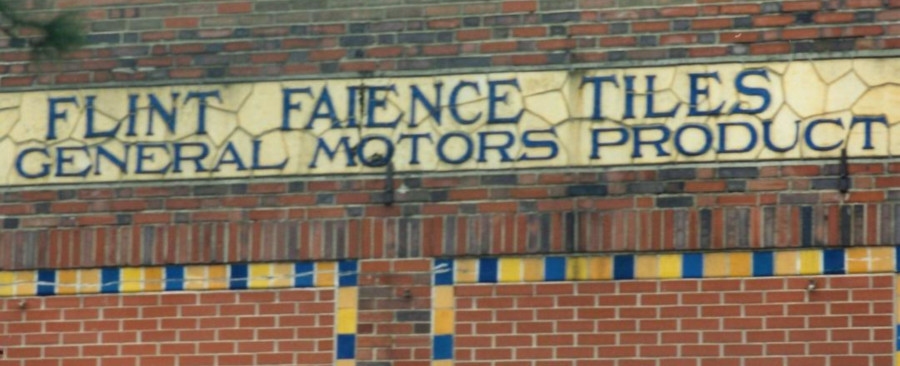 The Flint Faience Tile building sign
The Flint Faience Tile building sign
FLINT, MICHIGAN – Albert Champion a native of Paris, France, relocated to Boston, Massachusetts early in the 20th century. He was noted as a premier bicycle and later a motorcycle racer. With motorcycles, he experienced difficulty in finding spark plugs. He decided to design and manufacture his own spark plugs under the creation of the Champion Ignition Company.
Nearly 800 miles west of Boston, in Flint, automaker Billy Durant was in charge of the Buick Motor Company. He was purchasing spark plugs from New Jersey – based Rajah Plugs.
In 1908, Champion met with Durant exhibiting prototypes of his spark plugs. He stated he could produce better quality and less expensive plugs than Rajah.
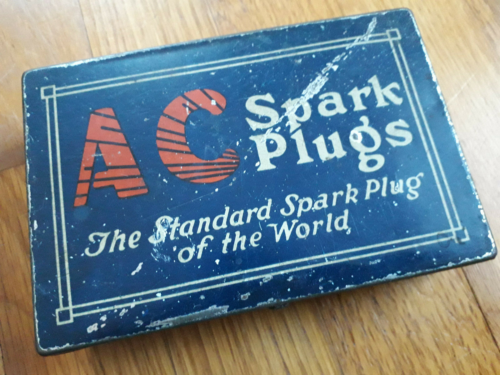 An old AC spark plug package
An old AC spark plug package
The deal was sealed. Champion with his wife and 11 employees arrived in Flint to manufacture spark plugs for Buicks. Soon after, Durant purchased Cadillac and Oldsmobile and formed General Motors (GM) Corporation.
By 1920, America was entering the dawn of significant consumerism, especially with cars and trucks. A significant rift occurred within GM’s board of directors and senior management. Durant was ousted from GM. In 1921, he established another company, Durant Motors, which operated until 1933.
Alfred P. Sloan became the new GM president.
GM’s spark plug division, known as AC Spark Plug, was located, in part, on Harrison Street and Industrial Avenue. AC soon expanded operations to a nearly 217,000 square foot facility on Dort Highway at Davison Road.
Spark plugs are basically comprised of metal, wire, and ceramic; they were baked in mammoth kilns. However, due to spark plug demand powering GM four- and six-cylinder engines, kiln production was limited to only a partial operational day. It was a significant expense to power up, shut down and again power up the kilns.
What could be a logical option to fully utilize the kilns?
The Birth of Flint Faience Tile Company
According to Flint resident and authority on Flint Faience tiles, Ken Galvas, Champion approached Carl Bergmans, a ceramic tile maker located in Zanesville, Ohio. Bergmans’ tile making experience included using tunnel kiln ovens where tiles rolled through on a conveyer belt system. This production technique was what Champion offered in Flint. Bergmans jumped on the opportunity to utilize GM’s kilns during off-hours.
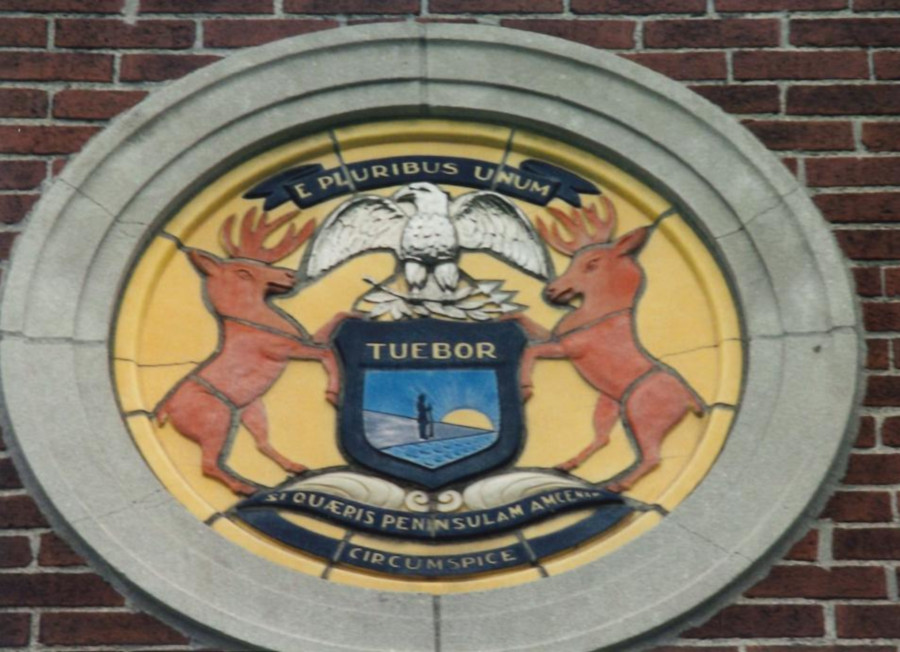 A Flint Faience Tile of the State of Michigan Seal
A Flint Faience Tile of the State of Michigan Seal
Bergmans arrived in Flint and hired Mexican-born designer and artist, Julio Haro, who was seeking work with GM. In 1921, the Flint Faience (pronounced: fy-AHNS) Tile Company was born, under GM ownership.
Galvas noted the company’s target sales audience was not directly to households and homeowners, but rather to architects, general contractors, and interior decorators.
Tile Production
Using decades of ceramic tile product experience, Bergmans used northeastern Ohio clay soil. Once the clay arrived in Flint, it was mixed with water and slowly beaten into a creamy and smooth mixture. This mixture was poured into design forms and rolled through the kilns.
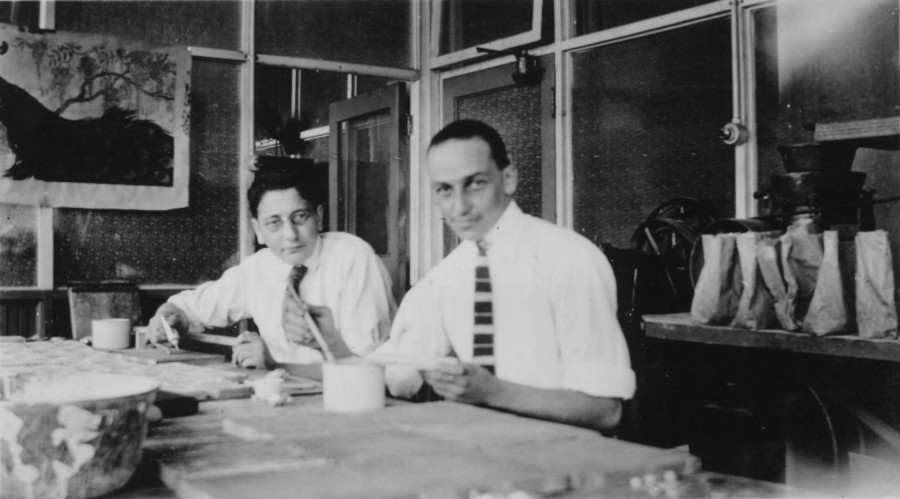 Flint Faience Tiles designers at work
Flint Faience Tiles designers at work
The process created two basic types of ceramic tiles. The first is Vitrocraft tiles, also known as bisque. These less expensive tiles were often used for flooring. They were fired in periodic kilns -- static ovens that baked tiles with periodic bursts of heat.
The firing took up to nine days to complete, with several days devoted to gradually increasing the temperature, more time for baking, and then additional time for a slow cooling process. Cooling could not be hurried, lest the tiles develop cracks.
The second style is known as Faience tiles, which were hand-dipped in raw glaze and then fired at temperatures around 1,900 degrees. These tiles tended to be decorative in use.
The lower heat on these tiles helped to fuse the glaze to the clayware. Here is where Bergmans' tunnel kilns came into play. Fueled by oil, they were about 75 feet long. Tiles were placed in what were called "railroad cars," layered singly, and then run through the tunnel kiln. The grog with which the clay was mixed also helped to keep the tiles flat during firing. The heating and cooling process took up to nine hours, sometimes longer. The cooling was done slowly, beginning about halfway through the process, to avoid cracking the tiles, which tended to be decorative in use.
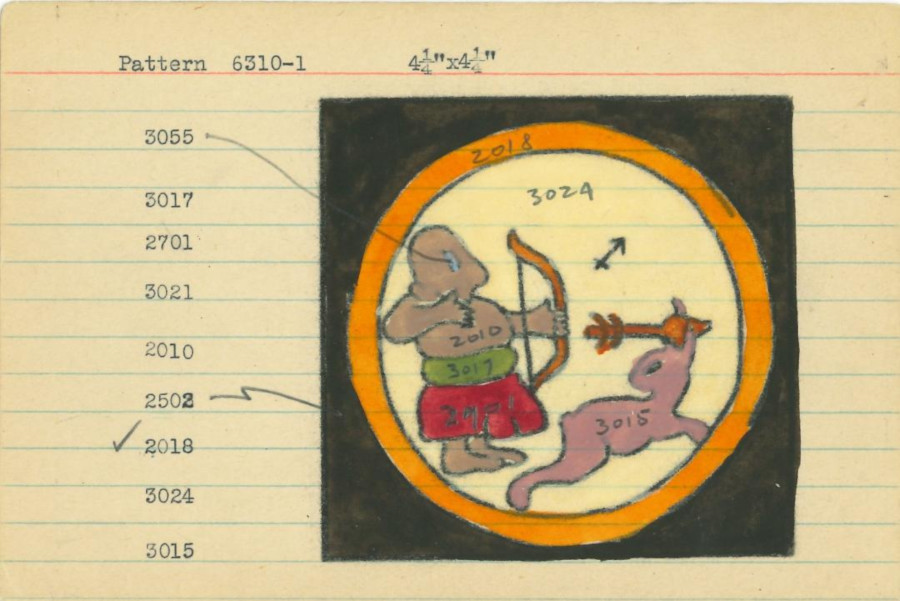 Flint Faience Tile artwork numbering
Flint Faience Tile artwork numbering
With both production tiles, the shapes and styles were varied. The most popular were squares, rectangles, circles, diamonds, hexagons, and even arrowheads. There were also instances where they were shaped into fruits, animals, and human forms.
In many instances, tiles were numbered on the reverse side, so that when they arrived at their destination they could be easily assembled into their design pattern.
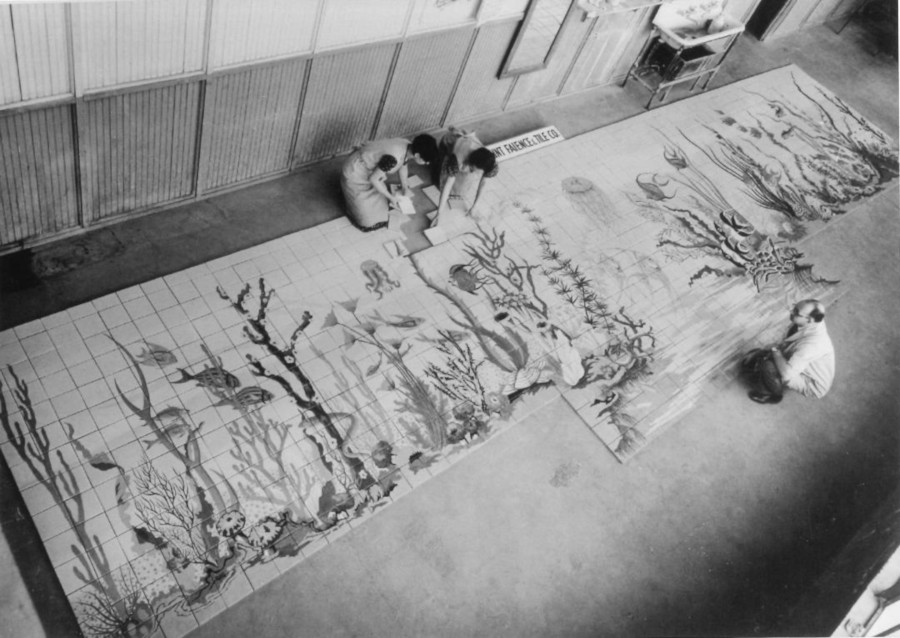 Flint Faience Tile design team
Flint Faience Tile design team
During the 1920s, there were nearly six dozen decorative tile production facilities around the country. Flint Faience tiles were recognized as being “meticulously hand crafted” by skilled glazing and hand-painting artisans.
Flint Faience tiles found their way into GM executives’ homes and other residences. In addition, the Flint tiles were found in hotels, apartments, government and commercial offices, hospitals, schools and universities, theaters, houses of worship, and museums. Peru’s Presidential Palace also utilized Flint Faience tiles.
Galvas also mentioned that the Flint tiles were used in swimming pools onboard the ocean passenger liners the USS Manhattan and Washington.
Detroit’s Masonic Temple, the largest in the world, has Flint Faience tiles throughout the 80,000 square foot facility among its 1,037 rooms.
Flint Faience Ends Production
As the US economy began to recover from the Great Depression, GM vehicle production increased. Production in 1932 was 522,000 units, climbing to 750,000 units in 1933.
Even though Flint Faience was a profitable division, GM needed more production time to produce spark plugs for its four, six, and now eight-cylinder engines.
In 1933, GM spark plug plants located across the country were consolidated and brought to Flint for production. A number of Flint Faience employees were offered positions elsewhere within GM operations.
Closing Stories
An August 2007 MLive/Flint Journal feature profiled an auction of two 12-piece Flint Faience tile sets benefiting the United Way of Genesee County.
In the story, Galvas said a portion of the tiles came from the former Harrison Street facility’s stairway. The building was razed in the mid-1970s.
Other tiles were obtained from retired AC employees who received tiles as a parting gift. In some instances, they featured a spark plug design.
Diana Phillips and Allan Griggs of Flint’s historic Knob Hill Bed and Breakfast revealed Flint Faience tiles are featured on the walls of three of their bedrooms, in their kitchen and on the adjacent sunroom floor.
Sloan Museum of Discovery archivist Jonathan Kirkwood said the museum offers a Flint Faience tile exhibit, located at the far end of the History Gallery leading into the Durant Vehicle Gallery.
Throughout the Flint metropolitan region and nation, you will still find Flint Faience tiles within residences and other buildings on flooring, fireplaces, living rooms, bedrooms, and bathrooms.
You can find numerous online resources selling Flint Faience tiles.
Jeffrey D. Brasie is a retired health care CEO. He frequently writes historic feature stories and op-eds for various Michigan newspapers. As a Vietnam-era veteran, he served in the U.S. Navy and U.S. Naval Reserve. He served on the public affairs staff of the secretary of the Navy. He resides in suburban Detroit.



